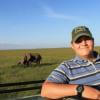Wildlife Crime Tech Challenge: Winners Announced!
22 January 2016 12:00am
Global Forest Watch Small Grants Program 2016
19 January 2016 12:00am
Introductions
10 December 2015 8:13pm
17 January 2016 9:08pm
Hi,
I am jason Holmberg from WildMe.org. I am one of the developers of Wildbook (wildbook.org), an open source data management platform for wildlife research. I'm using ML as part of the IBEIS.org project to boost and metascore multiple computer vision algorithms for individual humpback and sperm whales. David, I would love to speak offline if you have the time: [email protected].
Cheers,
Jason
New Groups - what's in development and what would you like?
14 January 2016 3:02pm
Playing with Complexity: Games and Systems Thinking
13 January 2016 12:00am
DJI and Ford launch a competition with $100,000 prize
12 January 2016 2:59pm
GIS Storytelling: How Story Maps can harness the power of maps and geography to promote conservation
12 January 2016 2:54pm
Can gaming help conservation? - Wildsense Tiger App
27 November 2015 11:01am
28 December 2015 7:09pm
Hi Steph,
Thanks for your message. I would be delighted to answer your question about Wildsense.
You are correct that our aim is to do a lot more than raise awareness and engange citizens with our Wildsense Tigers game.
We are using images from a range of image sharing websites that have been uploaded by people online and publicly shared. Each photograph contains valuable information that often includes the time and location that the photograph is taken. If we can understand when a photo was taken, where it was taken, and the individual animal in the photograph, then we can start to build up a picture of the movement of individuals. We are benefiting from people power from the users that are both indirectly uploading photographs online and also directly interacting with our Wildsense game. We are combining this with computing power with our data analysis, computer vision and machine learning software.
We are doing this experiment on a large scale and we believe that "the wisdom of the crowd" will enable us to gather and analyse enough information so that we can build an accurate picture. We started with wild tigers and our plan is to create a platform that can be used for other species as well. We are working on other animals already behind the scenes.
I hope that answers your question.
Best wishes,
Aaron Mason
11 January 2016 1:29pm
Hi Aaron,
It's a great concept of using gaming for the benefit of conservation, but I do have one big question about Wildsense and tigers. Since poaching is one of the main threats to the 3,000 or so remaining wildl tigers, there are great risks involved with publicizing the location and timing of any tiger sightings.
Furthermore, this approach can probably only work for Bengal tigers, since other tiger species, such as Sumatran and Malayan, are very rarely sighted, even by the most dedicated conservationists ( or poachers), as their jungle habitat is so dense. For Bengal Tigers, there are already ventures for online monitoring and identificaton, such as Tigernation.org.
Good luck with your project. Barbara from BiodiversityBusiness.
11 January 2016 6:33pm
Hi Barbara,
You are right in that cyberpoaching is becoming an increasing risk. I have seen various cases where information posted on social media has provided too much information and then ended up in the wrong hands (e.g. http://www.army.mil/article/75165/Geotagging_poses_security_risks/).
We need to be careful about the accuracy of information that is disclosed. Providing an approximate time and location seems to be the most popular adopted approach.
Hacking is another issue. For example, I have seen research demonstrating the potential to gain unauthrised access to GPS collar data.
Our main focus has been the Bengal Tiger but we want to see how much we can learn about other tigers as well. Our end goal is to support a range of animal species.
P.S. I am pleased that you are aware of http://www.tigernation.org - I co-founded it :)
Google Releases Tensor Flow
18 November 2015 12:10am
20 December 2015 7:05pm
"TensorFlow, you see, deals in a form of AI called deep learning. With deep learning, you teach systems to perform tasks such as recognizing images, identifying spoken words, and even understanding natural language by feeding data into vast neural networks. "
Would this be applicable to an acoustic monitoring network? For example. my research has shown tigers have unique, identifiable vocalizations down to the individual and sex. If this software is applied to my recording network for tigers, would it be able to automatically recognize and categorize these individuals?
For example: when it hears Tiger 108, it would know and then input that it heard Tiger 108 at a particular time and date.
11 January 2016 12:38pm
The catch will be (and for any neural network or AI type learning I would expect the same) the training phase. If you are able to tell the sounds apart or identify a specific sound as belonging to a certain individual, the AI should afterwards be able to automatically identify the critical factors needed to distinguish the voices of the individuals. But it will need enough input from each individual as well as the different vocalizations used by tigers. AFAIKT it will be able to do this automatically afterwards, but I am not sure if (a) you will get enough identifiable vocalisations and (b) with a wide enough range of typical tiger vocalisations for it to be really reliable. Training on zoo animals might work? I am also interested in this, but for jackals instead of tigers.
11 January 2016 2:30pm
I'd like to suggest our open source package Wildbook (http://www.wildbook.org) as a base data management platfor for this. I agree with the above that there are a number of challenges around the vocalizations themselves, but having the identity information in a good database and data model is a great foundation. That's what we're doing for our computer vision/deep learning project at www.IBEIS.org.
Our non-profit WildMe.org is running both. Feel free to contact us with questions. We have played with time series matching (often used for speech recognition)...but actually for whale flukes. Would be happy to discuss potential for audio ID.
Claude Miaud's eDNA presentation at 2015 Fuller Symposium
7 December 2015 3:12pm
15 December 2015 4:47pm
Thanks for sharing this, Sarah.
7 January 2016 11:09am
Article about Claude Miaud's presentation at the Fuller Symposium:
https://www.wildlabs.net/resources/thought-pieces/biodiversity-drop-water-new-opportunity-edna
Gaming with real data
4 January 2016 11:55am
Deep Learning Image Recognition of Species In Global Wildlife Crime Reporting
31 December 2015 7:28pm
Ecological Acoustics (Ecological Informatics special issue)
29 December 2015 9:56pm
Satellite imagery grants from Digital Globe Foundation
28 December 2015 3:22pm
ArcGIS subscriptions through ESRI Conservation Program grants
28 December 2015 2:50pm
Google Earth Outreach and Geo for Good conference
24 December 2015 8:47pm
New article about WILDLABS.NET: Where Technology and Conservation Meet
24 December 2015 4:33pm
Biodiversity in a Drop of Water: The New Opportunity of eDNA
24 December 2015 12:00am
Deep Coral Reef Exploration and Discovery: Two-way Technological Flow
24 December 2015 12:00am
Mobile reporting for rapid wildlife health response
23 December 2015 5:03pm
Mobile Phone Reporting for Rapid Wildlife Health Response in Uganda
22 December 2015 12:00am
Big Data and Conservation: Deluge or Drought?
22 December 2015 12:00am
Achieving Moonshots: Advancing Humankind and Preserving Nature
22 December 2015 12:00am
Cheap Space, DIY Imaging and Big Data
21 December 2015 12:00am
Helpful Info
18 December 2015 3:43pm
MapBiomas: New mapping platform will track annual deforestation in Brazil
17 December 2015 8:44pm
Drones as elephant deterrent (herding device)
24 November 2015 6:32pm
17 December 2015 6:39pm
Hi Dave,
I believe with any DJI drones you can plot out the course of a drone and let it fly along the route with you controling the speed and height of the drone. The limitation is that it has to eb within a mile of the pilot.
Regards,
John
17 December 2015 6:43pm
True, but ideal the navigation system would need to be more interactive to be able to respond to the elephant movements in real-time.
eDNA sampling to detect invasive snails in shipping ballast water
15 December 2015 5:04pm
16 December 2015 12:05am
Thank you for sharing!
The Impact of the Internet of Things
10 December 2015 12:00am
Think for Tigers challenge by WildCRU at Oxford
13 November 2015 7:55pm
9 December 2015 5:12pm
Oh wow. This is perfect for what I do... tracking tigers by their voices alone!














10 December 2015 8:41pm
To start things off...
I'm David J Klein. My background is in deep learning, machine learning, neuroscience, neuromorphic computing, and signal processing. I've been doing the startup thing Silicon Valley for the last 11 years after being in academia for a while. I've worked on products ranging from speech recognition systems, to cloud-based deep learning platforms. These days, some use the blanket term "AI".
For the last several years I've been developing software for Conservation Metrics which gives their analysists the ability to use deep learning to process large volumes of audio and image data from remote sensors in order to monitor population density changes of endangered species, detect collisions of birds and bats with infrastructure, and find rare and elusive species.
More broadly, I'm interested in integrating many disparate sensing domains from eDNA, to land-based sensors, to GIS data in order to provide tools to conservation scientists and ecologists that will enable them to develop a higher resolution understanding of the health of ecosysems around the globe and their response to positive or negative human interventions.
I'm looking forward to interacting with you all. Please let me know what other questions you have for me, and other ways I can help.
Regards,
David